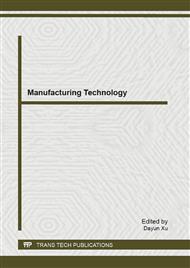[1]
G. Cleveland, R.G. Schroeder, J.C. Anderson, A theory of production competence, Decision Science. 20 (1989) 655-688.
Google Scholar
[2]
L. Avella, D. Vázquez-Bustelo, The multidimensional nature of production competence and additional evidence of its impact on business performance, International Journal of Operations & Production Management. 30 (2010) 548-583.
DOI: 10.1108/01443571011046021
Google Scholar
[3]
S.K. Vickery, A theory of production competence revisited, Decision Science. 22 (1991) 635-643.
Google Scholar
[4]
S.K. Vickery, C. Droge, R.E. Markland, Production competence and business strategy: do they affect business performance? Decision Sciences. 24 (1993) 435-455.
DOI: 10.1111/j.1540-5915.1993.tb00482.x
Google Scholar
[5]
S. Terjesen, P.C. Patel, J.G. Covin, Alliance diversity, environmental context and the value of manufacturing capabilities among new high technology ventures, Journal of Operations Management. 29 (2011) 105-115.
DOI: 10.1016/j.jom.2010.07.004
Google Scholar
[6]
A.L. Stinchcombe, Social structure and organizations, in: J.G. March, (Ed. ), Handbook of Organizations, Rand McNally, Chicago, Illinois, 1965, pp.142-193.
Google Scholar
[7]
H.K. Bowen, K.B. Clark, C.A. Holloway, S.C. Wheelwright, The Perpetual Enterprise Machine, Oxford University Press, New York, (1994).
Google Scholar
[8]
T.P.C. Fan, Determinants of de novo new entrant survival in the liberalized intra-European scheduled passenger airline industry, Transport Research Part E: Logistics and Transportation Review. 45 (2009) 293-306.
DOI: 10.1016/j.tre.2008.09.009
Google Scholar
[9]
F. Wiengarten, B. Fynes, M. Pagell, S. de Búrca, Exploring the impact of national culture on investments in manufacturing practices and performance: an empirical multi-country study, International Journal of Operations & Production Management. 31(2011).
DOI: 10.1108/01443571111126328
Google Scholar
[10]
M. Safizadeh, L. Ritzman, D. Mallick, Alternative paradigms in manufacturing strategy, Production and Operations Management. 9 (2000) 111-127.
DOI: 10.1111/j.1937-5956.2000.tb00328.x
Google Scholar
[11]
K. Dooley, A. Subra, J. Anderson, Maturity and its impact on new product development project performance, Research in Engineering Design. 13 (2001) 23-29.
DOI: 10.1007/s001630100003
Google Scholar
[12]
D. Kuhn, C. Wells, J. Armitage, K. Cusick, S. Garcia, M. Hanna, P. Malpass, H. Pierson, A Description of the Systems Engineering Capability Maturity Model Appraisal Method Version 1. 1, CMU/SEI-96-HB-004, Carnegie Mellon Software Engineering Institute, Pittsburgh, Pennsylvania, (1996).
DOI: 10.21236/ada310235
Google Scholar
[13]
P.S. Booz, T.J. Allen, G. Hamilton, New Product Management for the 1980's, Booz, Allen and Hamilton Inc., New York, (1982).
DOI: 10.2172/12227106
Google Scholar
[14]
A. Griffin, PDMA research on new product development practices: updating trends and benchmarking best practices, Journal of Product Innovation Management. 14 (1997) 429-458.
DOI: 10.1111/1540-5885.1460429
Google Scholar
[15]
I.T. Oya, O.R. Walter, Analysis of the characteristics of projects in diverse industries, Journal of Operations Management. 16 (1998) 43-61.
Google Scholar
[16]
T. Alhazmi, R. McCaffer, Project procurement system selection model, Journal of Construction Engineering and Management. 126 (2000) 176-184.
DOI: 10.1061/(asce)0733-9364(2000)126:3(176)
Google Scholar
[17]
L.S. Pheng, Q.T. Chuan, Environmental factors and work performance of project managers in the construction industry, International Journal of Project Management. 24 (2006) 24-37.
DOI: 10.1016/j.ijproman.2005.06.001
Google Scholar
[18]
R. Müller, J.R. Turner, Matching the project manager's leadership style to project type, International Journal of Project Management. 25 (2007) 21-32.
DOI: 10.1016/j.ijproman.2006.04.003
Google Scholar
[19]
J.S. Kim, P. Arnlod, Manufacturing competence and business performance: a framework and empirical analysis, International Journal of Operation & Production Management. 13 (1992) 4-25.
Google Scholar
[20]
J.S. Kim, J.G. Miller, The Manufacturing Future Factbook: 1990 U.S. Manufacturing Futures Survey, Boston University Manufacturing Roundtable Research Report Series, Boston, Massachusetts, (1990).
Google Scholar
[21]
F.Y.Y. Ling, S.P. Low, S.Q. Wang, H.H. Lim, Key project management practices affecting Singaporean firms' project performance in China, International Journal of Project Management. 27 (2009) 59-71.
DOI: 10.1016/j.ijproman.2007.10.004
Google Scholar
[22]
C.C. Chen, An objective-oriented and product-line-based manufacturing performance measurement, International Journal of Production Economics. 112 (2008) 380-390.
DOI: 10.1016/j.ijpe.2007.03.016
Google Scholar
[23]
J.F. Hair, W.C. Black, B.J. Babin, R.E. Anderson, R.L. Tatham, Multivariate Data Analysis, sixth ed., Prentice-Hall, Upper Saddle River, New Jersey, (2006).
Google Scholar
[24]
R.P. Bagozzi, Y. Yi, L.W. Phillips, Assessing construct validity in organizational research, Administrative Science Quarterly. 36 (1991) 421-458.
DOI: 10.2307/2393203
Google Scholar
[25]
T. Li, T. Cavusgil,. Decomposing the effects of market knowledge competence in new product export, European Journal of Marketing. 34 (2000) 57-80.
DOI: 10.1108/03090560010306205
Google Scholar


